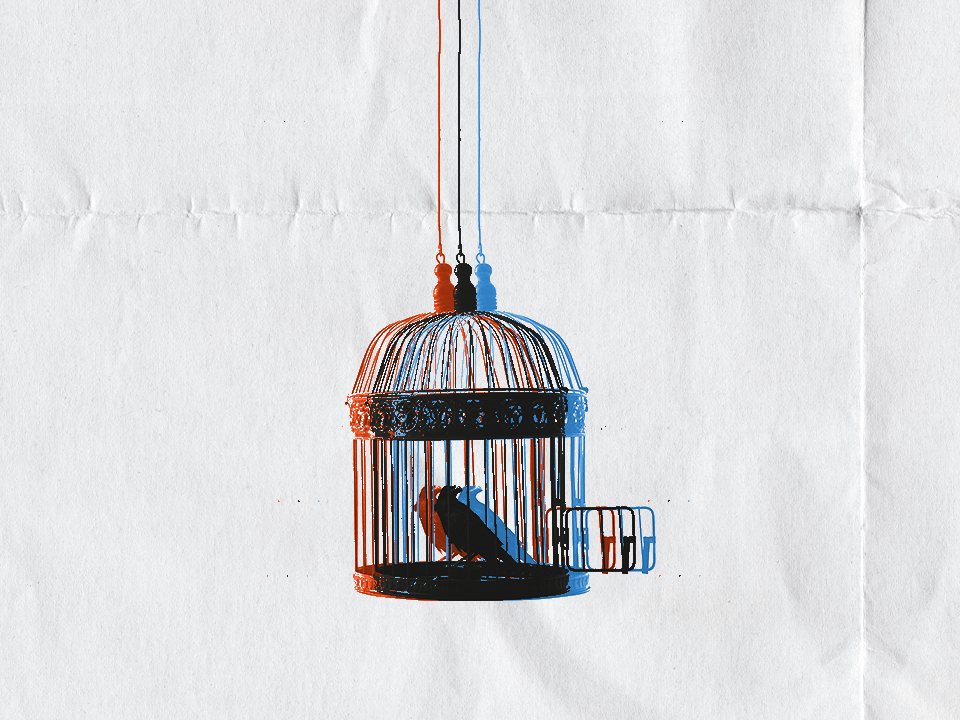Whatever You’re Irrationally Afraid Of, Here’s How to Overcome It
Not easy. Definitely worth it.
We all have our own brand of nightmare fuel. Large bodies of water, uninvited creatures invading our homes, the creepy girl from The Ring. But if those kind of scaries keep you from living the life you want or get in the way of how you function, it might be time to actually face your fears.
Maybe your partner has a dog but your fear of canines stops you from moving in together. Or your fear of flying means that you drive half a day to get to your sister’s wedding instead of jumping on a plane. Honestly, it happens; fear is a completely normal reaction to what we think is dangerous—even if we’re not realistically in danger, explains psychotherapist Jennifer Daigle, LPC, NCC. (That's catastrophizing for ya!)
That said, a lot of good can come from tackling a fear that’s limiting you. (A closer relationship with your partner and their dog! Less time spent on the road!) If something keeps you from reaching your goals or enjoying time with your people, it’s worth confronting, Daigle says.
Yeah, this can be intimidating as hell, but it is doable. Even if you’re convinced facing your fear will go horribly wrong, that’s probably not the case. “When something that isn’t dangerous feels really scary, our imagination is creating the narrative about what the outcome of facing that thing will be,” notes Daigle, who learned to face her own fear of germs (linked to her OCD) with the help of a therapist.
So how do you even do that? Here, we asked experts for the exercises and mindset shifts that can help you face fear and start thriving.
Remember your “why.”
When you’re scared, you might be like, “Um, hi! Why the hell would I want to do this?!” But remembering all the good things that can come with facing that fear can motivate you to do it anyway. For example, if Daigle didn’t face her fear of germs, she says she wouldn’t be able to own a dog, leave her house, or see her friends in public.
Make a vision board of how you want your life to look after you conquer your fear, Daigle suggests. Maybe you piece together a collage of places you’ve always wanted to visit or mini milestones you want to accomplish (like going camping or giving a toast). Keep it handy or take a picture of it so you can look at it whenever you’re feeling unsure if you’re up for the challenge, says Daigle.
Watch someone else do it.
Giving a speech, being around dogs, or going to the dentist can be intimidating for sure. To practice sitting in the discomfort without actually doing it yourself, watch other people do those things on YouTube or in real life, suggests Daigle. It can still be a challenge to get through, but witnessing others experiencing the scary thing shows us that it might not be so bad, she says. Just make sure you’re careful about what videos you watch online, she adds. You definitely want to avoid any worst-case scenario clips.
Do a mental rehearsal.
Speaking of, if you tend to worry about all of the horrible things that could happen when you do something you’re scared of, go ahead and also think about how you’d (effectively!) navigate that scary situation, says anxiety specialist and clinical psychologist Alex Littleton, PsyD. “If we imagine ourselves coping really well in a situation that's scary, that makes us more likely to actually cope with it well in the moment. … It’s like, ‘I’ve dealt with this before. I can deal with this again,’” Dr. Littleton explains.
Say you’re afraid to do a presentation in front of some really important people in suits. Picture yourself up on stage, palms sweating, heart racing, mind going blank. Frustration flares and you feel unprepared or incapable or dumb. Visualize all of that. Then, watch yourself cope. Picture reaching for a water bottle, taking a sip, walking to the other side of the stage, breathing deep, and pausing to buy yourself time, says Dr. Littleton. Look at you go!
Build up to your biggest fear.
Facing creepy things in bite-sized pieces can help you build confidence so you can work toward your ultimate goal of overcoming your fear. You can do this by ranking situations from 1 to 10—1 being not very scary, suggests Daigle. Working your way from a little scary to mid-level scary to WTF scary, do each thing until it feels pretty easy to handle. Once something feels manageable, move on to a bigger challenge.
The last thing on your list should not be anything you wouldn’t face in real life. For example, if spiders freak you out, you (obviously) don’t have to sit in a room with 100 of them, licensed clinical psychologist Tamara Jacobs Sussman, PhD, previously told Wondermind.
So maybe you start by looking at pictures of spiders. Then, you can watch videos of spiders, go on a hike in nature where spiders exist, stand by as your friend holds a spider, then maybe touch one. If you can survive a situation on your list, it’s proof you can do it again, Daigle notes.
Don’t fight it.
Think about what your body did the last time you were scared. Most of the time, our hearts start pumping, we breathe faster, we sweat in places we didn’t know we could sweat, and our muscles get tense, notes Dr. Littleton. Unfortunately, that fear response can add to the terror we’re already dealing with.
Instead of wishing this fear response away and getting in your head about it, just notice how your body’s reacting in the moment with as little judgment as possible, Dr. Littleton suggests. Then, try relaxing any tension that might be making your fear worse. For example, if you’re asking a question during a Zoom meeting and you realize your hands are clenched, try unclenching, loosening your shoulders a bit, and exhaling, he says. It’s sorta like quicksand: “If you fall into a pit of quicksand and you start to thrash and fight, it's only going to pull you deeper in,” he explains.
See a mental health professional.
With the help of a therapist, you can learn to face your fear, get to the bottom of where it comes from, and feel seen by someone who is paid not to judge you. That can be a winning combination if you feel like the things that terrify you are messing with the way you do life.
They might start by working through your fears in manageable steps, like we talked about (this is called exposure therapy). And your therapist might even participate, says Dr. Littleton, who’s helped people scared of germs literally go touch toilets. (Gross, but also…very cool of him!)
A mental health pro will also look into whether your aversion is a sign of a mental health condition, like specific phobia or another anxiety disorder, or if it stems from something else. The best part is that they do it without making you feel ashamed about whatever gets under your skin. And who doesn't want more of that?
Wondermind does not provide medical advice, diagnosis, or treatment. Any information published on this website or by this brand is not intended as a replacement for medical advice. Always consult a qualified health or mental health professional with any questions or concerns about your mental health.




